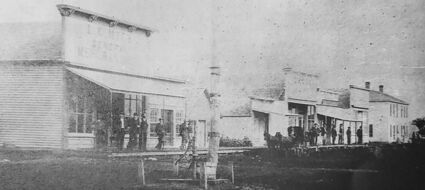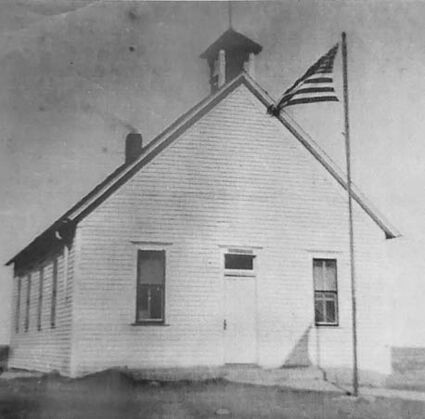Sixteen High Schools have served Jewell County youth (Salem pehaps the less well-known)
High School Salem, Kansas and Salem
August 18, 2022

Main Street in Salem in the early or mid-1880s. The building on the far right was the Hotel Wilson. It was moved to Lebanon and became part of the Bunker Hotel. The Mick Building on the far left was later owned by John W. Ward. In 1906, it was the last store remaining in Salem. Photo from "The Village of Salem" by Virginia Alexander.
To date, there are thought to have been a total of 16 high schools which provided education for students in Jewell County. Of course, not all were in existence at the same time. But spanning Jewell County's history, from near the beginning in 1876 to the present day, an education "higher" than common school (eighth grade) was and is available in Jewell County. Today, Rock Hills USD 107, is the only high school in Jewell County.
The first newspaper item about "high school" in Jewell County is found in the March 2, 1876 Jewell County Diamond. It reads "Jewell high school closed yesterday noon." Then in the March 11, 1880 Jewell County Monitor, we read the question "Does the Burr Oak High School have grammar in its course of instruction?" The Dec. 7, 1882 Burr Oak Reveille discusses the question about a graded school for Burr Oak with "eight grades in the elementary and two in the high school."
Many editions in the Jewell County Monitor from August to October of 1882 contained an advertisement announcing the "Jewell City High School will open October 2, 1882. The school will consist of four departments, Primary, Intermediate, Grammar and High School."
The Jewell County Monitor of Sept. 27, 1882, describes the Mankato schools with the comment "Prof. Allen also has a 'high school' course composed of three students." Articles about the two high schools, Jewell and Mankato, include information about the first eight grades and what teachers were teaching them. This leaves no doubt the "high school" was a curricular level above the common school.
But there were more high schools to follow those first three. Alphabetically the Jewell County high schools are; Athens, Burr Oak, Esbon, Formoso, Ionia, Jewell, Lovewell-Sinclair, Mankato, Montrose, Northbranch Academy, Otego, Randall, Rock Hills (USD 107), Salem, Webber and White Rock (USD 104).
Yes, there was a Salem High School in Jewell County. It is, perhaps, the least well-known of the county's high schools. There is newspaper evidence showing a high school in the town from 1883 to 1888. The school was on lots 128-133 in the original plat of the town of Salem. The Salem School District No. 2, the second school district in the county, was organized in 1872.
The high school and the town of Salem was located on what is now 20 Road between V Road and W Road in White Mound Township, just a mile from the Smith County line. The school lots were on the west side of 20 Road and on the south side of the town.
According to What Price White Rock by Harry E. Ross, Salem was laid out by Hy Browning, C. P. Miller and George W. Smith in 1872. A Salem Chronicle article from May of 1882 gives Jan. 25, 1872, as the date the town was platted. Each of the three men were said to have donated a strip of land for the fledgling town.
Browning and Miller are credited by Melvin D Bruntzel's Quick Reference to Kansas with naming Salem. They chose the Hebrew word "Shalom" meaning "peace" or "from Jerusalem." Two of the founders, Miller and Smith, left Salem and Jewell County but Browning remained. He is referred to as "the father of Salem" and was a well-respected citizen of the community.
The definitive history of Salem, The Village of Salem, was compiled and organized by Virginia Alexander (Esbon). Her work consists of hundreds of pages of memorabilia, newspaper articles, stories, family histories, maps and photographs. There is one volume of information about Salem and five volumes of stories and histories of the area townspeople and farmers.
Thus far the first newspaper mention of Salem is an ad in the Aug. 30, 1872 Jewell City Weekly Clarion for the Shingle Mill operated by J. S. Miller and T. J. Burrow.
In 1880, the Kansas Gazetteer noted the population of Salem was 200 with four physicians serving the community. Additionally, there were two blacksmiths, two general stores and a hardware store. Salem boasted a hotel (Traveler's Home), a milliner, a lawyer, a justice of the peace and a notary public. There was also a wagon maker, a livery stable, a saw and grist mill, plus a well auger and a carpenter.
By 1881, Salem also had real estate agents, a bathing establishment, a constable, a furniture store, a dealer in nursery stock and at least three grocery stores. The town had a "a band as good as the county affords." There was also a billiard hall, a barber, a dealer in stationary and a music teacher. (April 22, 1881 Burr Oak Reveille)
Salem had the Salem Post Office before the town was platted. It was established on Sept. 12, 1871, with George W. C. Smith as postmaster. Salem was the 16th post office established in Jewell County. The office was eventually served by 16 different postmasters.
The May 18, 1882 Salem Chronicle also reported there was a Sunday School organized with "much interest." There was also a group of United Brethren with J. McMillan as pastor. (Salem Chronicle Oct. 19, 1882)
A Methodist Episcopal congregation with a pastor "assigned to this Circuit" and who was "going to make Salem his home" was announced by the Salem Chronicle July 13, 1882. The congregation was officially organized on May 5, 1883 and a church built in 1884.
In 1920, a new church was built which served the congregation until the few remaining members voted to dissolve on April 20, 1966. The history of the church spanned 83 years. The church is memorialized by a monument on 20 Road, where Salem was located. There is also a marker in the Salem Cemetery in memory of the 1920 church building.
The large monument on 20 Road was "Dedicated with gratitude to the sturdy pioneers who in 1883 founded the Salem Methodists Church – and to ones who follow. Eternal memory is revealed by their trust in God." Dedicated in 1959, the monument still stands. On a hill to the west is Salem Cemetery, the only two remnants left of the once thriving community.
For in the 1880s, Salem was thriving and growing, a center of commerce and trade in the area. It seems quite reasonable that in 1883, the community added a high school. About 10 newspaper items give some of the scant information about Salem High School. These items were printed in the Salem Argus and Jewell County Monitor from Nov. 23, 1883 to Nov. 14, 1888.
The items give attendance and student achievement information. During those years there was a teacher in the primary department (grades one to eight) and a principal in the high school. The high school was divided, in some years, into three grades or levels and in others into Grammar A and B and Intermediate A.
From this information it seems there were three years in the high school curriculum and that Salem High School never had a four-year curriculum. Nor has any mention of a commencement or a graduation surfaced. The scenario of fewer than four years in high school is found in the early history of other county high schools. As a community embarked on establishing a high school, they added curriculum and teachers as they were able.
Salem District No. 2 records in the Jewell County Registrar of Deeds office gives a bit more information. The district student census peaked in 1888 at 134 students. It was about that time the railroad came through the western part of Jewell County. But the railroad did not go through Salem.
The school census dropped by 30 students the next year. There is no mention of a high school in Salem after the 1888-1889 school year. The Nov. 14, 1888 newspaper report is the last known mention of Salem High School. The next Salem school report that has been located is found in the Nov. 10, 1892 Jewell County Monitor and gives no high school information – only the primary department information.

This photograph is Salem District #2 School taken in 1924, several years after the high school existed. The building had been built in the 1880s and used for all classes in the school district. Photo from "The Village of Salem" by Virginia Alexander.
Those years when Salem High School existed, 1883-1888, were the heyday of Salem's existence. The days when the population reached its peak of some 500 citizens, businesses were expanding and the area prosperous. But when the railroad "missed" Salem in 1887, much of the town packed up and moved.
Houses and businesses were moved, sometimes east to Esbon and especially northwest to "New" Lebanon. News items from 1887 to 1892 detail a continual exodus from Salem. Businesses and homes were hauled and skidded to their new locations near a railroad.
By 1906, little was left in Salem. The Esbon Times of Sept. 20, 1906 stated "Salem, once one of the best and most prosperous towns in Jewell County, is no more." The town site, 40 acres, was reported as being sold for $50 an acre. This was a town where "good corner lots sold as high as $1,000." Finally, "all that is left there now to mark the sight of the once flourishing town is one general store belonging to J. W. Ward & Son."
So, as for many a seemingly flourishing town – for want of a railroad the town was lost. And then, for want of a town, Salem High School was lost.















Reader Comments(0)